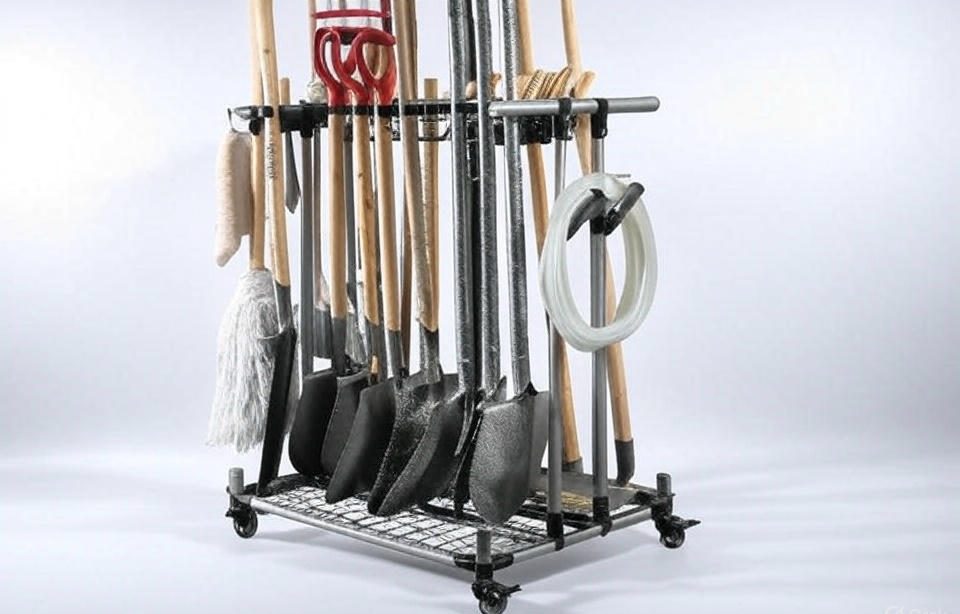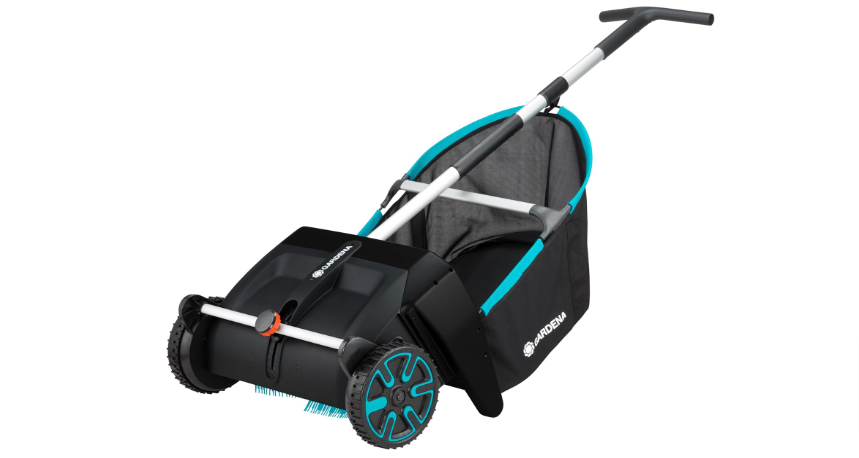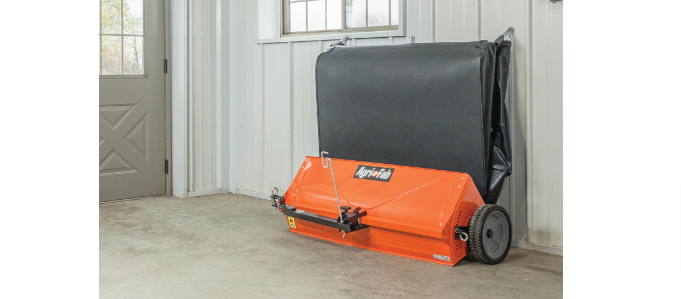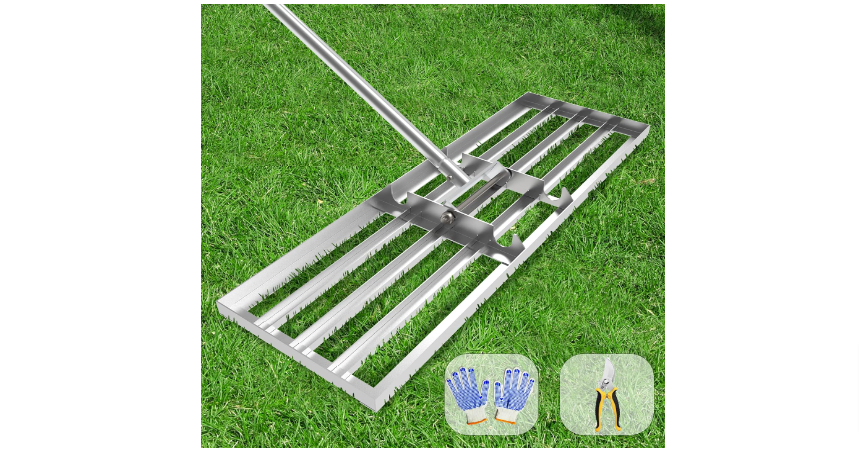Keeping your lawn and garden tools organized can feel like an uphill battle. Rakes scattered across the garage floor, shovels leaning precariously against walls, and hoses tangled in corners create chaos in what should be your organized sanctuary. The right lawn tool organizer transforms this frustration into functional storage that saves time, protects your investment, and maximizes your space.
Every homeowner faces the same challenge: how to store an ever-growing collection of garden equipment efficiently. Professional landscapers and weekend warriors alike need reliable storage solutions that withstand the test of time while keeping tools easily accessible. The perfect organizer combines durability, capacity, and intelligent design to create a system that actually works.
This comprehensive review examines five outstanding lawn tool organizers that stand above the competition. Each option offers unique advantages, whether you’re working with limited space, need maximum capacity, or require heavy-duty construction for professional use. We’ll explore their features, benefits, and potential drawbacks to help you make an informed decision.
Contents
What Makes a Great Lawn Tool Organizer?
Before diving into specific products, understanding the essential qualities of effective tool storage helps guide your selection process. The best organizers share several key characteristics that separate them from inferior alternatives.
Construction Quality and Materials
Superior lawn tool organizers use robust materials that resist weather, corrosion, and daily wear. Metal construction typically offers the best longevity, while high-quality plastics provide excellent value for lighter applications. The connection points, mounting hardware, and moving parts must withstand repeated use without loosening or breaking.
Capacity and Versatility
The ideal organizer accommodates your current tool collection while providing room for future additions. Versatility means handling various tool sizes and shapes, from long-handled implements to smaller hand tools. Adjustable components and multiple storage configurations increase the system’s usefulness across different applications.
Installation and Accessibility
Easy installation encourages proper use and reduces setup frustration. The best organizers include clear instructions, quality hardware, and straightforward mounting procedures. Once installed, tools should slide in and out smoothly without requiring excessive force or awkward maneuvering.
Space Efficiency
Effective organizers maximize storage capacity while minimizing floor space requirements. Wall-mounted systems excel in tight spaces, while freestanding units work well in larger areas. The design should complement your available space rather than overwhelming it.
Top 5 Best Lawn Tool Organizers: In-Depth Reviews
1. 68″ All Metal Garden Tool Organizer Wall Mount – The Premium Choice
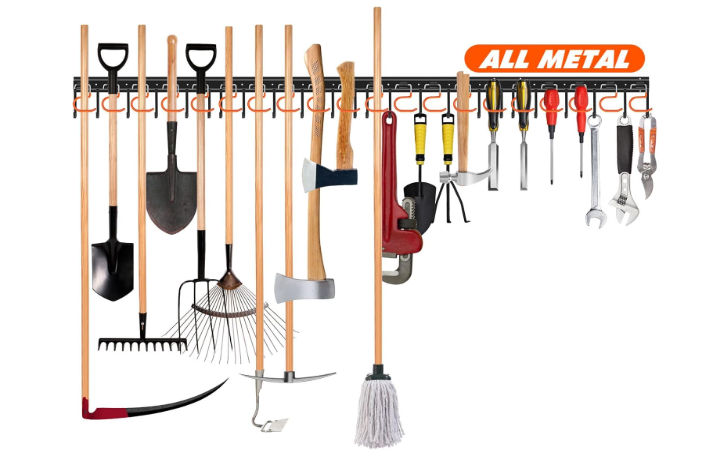
This impressive wall-mounted system represents the pinnacle of lawn tool organization technology. Standing at 68 inches tall, this all-metal organizer commands attention while delivering exceptional functionality for serious gardeners and landscaping professionals.
Construction and Design Excellence
The robust metal construction ensures decades of reliable service, even in challenging environments. Unlike plastic alternatives that crack or warp over time, this organizer maintains its structural integrity through temperature fluctuations, humidity changes, and constant use. The powder-coated finish resists rust, scratches, and fading while maintaining an attractive appearance.
The wall-mount design maximizes floor space efficiency while providing easy access to stored tools. Multiple hook configurations accommodate various tool types, from standard long-handled implements to specialized equipment. The vertical orientation takes advantage of unused wall space, transforming dead zones into productive storage areas.
Capacity and Organization Features
This organizer excels at handling diverse tool collections with its flexible hook system. The included hangers adjust to accommodate different handle sizes and shapes, ensuring secure storage without tool damage. The generous 68-inch height provides ample vertical storage for the longest tools while maintaining easy access for users of average height.
The strategic hook placement prevents tools from interfering with each other during storage and retrieval. This thoughtful design eliminates the frustration of tools falling when you remove one from the group. Each tool has its designated space, making inventory management and selection effortless.
Installation and Mounting Considerations
Wall mounting requires careful attention to stud location and proper hardware selection. The organizer’s substantial weight capacity demands secure attachment to structural elements rather than hollow wall anchors. Professional installation ensures optimal performance and safety, particularly in high-use applications.
The mounting hardware accommodates various wall types, including wood studs, concrete, and metal framework. Clear installation instructions guide the process, though basic construction knowledge helps ensure proper execution. Once mounted correctly, the system provides rock-solid stability for years of service.
Performance in Real-World Applications
Daily use reveals this organizer’s exceptional build quality and thoughtful design. Tools slide into place smoothly and stay securely positioned until needed. The metal construction handles heavy tools without deflection or stress signs, maintaining proper alignment over time.
Weather exposure tests the organizer’s durability, particularly in unheated garages or sheds. The protective coating resists moisture intrusion while preventing oxidation and corrosion. Temperature extremes don’t affect the metal’s performance, unlike plastic alternatives that become brittle in cold conditions.
Best Applications and User Types
This premium organizer suits homeowners with extensive tool collections and professional landscapers requiring reliable storage solutions. The robust construction justifies the investment for users who depend on their tools daily and need assured accessibility.
Large garages, spacious sheds, and commercial facilities benefit most from this organizer’s capacity and durability. The wall-mount configuration works particularly well in areas where floor space is at a premium but wall space is abundant.
2. 3 Tier Garden Tool Organizer – The Capacity Champion

This freestanding three-tier system revolutionizes garden tool storage with its impressive capacity and intelligent tiered design. Capable of organizing up to 78 tools, this organizer addresses the needs of serious gardeners and landscaping professionals who accumulate extensive equipment collections.
Revolutionary Three-Tier Design
The innovative tiered approach maximizes storage density while maintaining tool accessibility. Each tier handles different tool categories, creating natural organization zones that streamline selection and inventory management. The graduated height design ensures smaller tools don’t disappear behind larger implements.
The heavy-duty metal construction provides the structural strength necessary to support substantial tool loads across all three tiers. The engineering distributes weight evenly, preventing sagging or instability that plagues inferior designs. This stability remains consistent whether the organizer holds a few tools or reaches maximum capacity.
Exceptional Storage Capacity
With space for 78 tools, this organizer accommodates the most extensive residential collections and many commercial applications. The diverse storage configurations handle everything from standard rakes and shovels to specialized implements and seasonal equipment.
The tier system naturally separates tools by size and frequency of use. Commonly used items occupy the most accessible positions, while seasonal or specialized tools find homes in less prominent locations. This organization system reduces search time and improves workflow efficiency.
Versatile Placement Options
The freestanding design offers installation flexibility that wall-mounted systems cannot match. Position the organizer anywhere in your garage, shed, or storage area without permanent mounting requirements. This portability allows seasonal relocation or reconfiguration as needs change.
The stable base design prevents tipping while maintaining a compact footprint. The organizer works equally well against walls for space efficiency or in open areas for 360-degree access. This versatility adapts to various storage environments and user preferences.
Durability and Weather Resistance
The heavy-duty metal construction withstands outdoor environments and unheated storage areas. The protective finish resists moisture intrusion while preventing rust and corrosion development. This durability ensures long-term performance regardless of environmental conditions.
The robust engineering handles the dynamic loads created by tool insertion and removal without structural compromise. Connection points maintain their integrity through repeated use, eliminating the loosening problems common in lighter constructions.
Organization Efficiency
The three-tier system creates natural categories that improve tool management and selection speed. Users develop consistent storage patterns that reduce search time and eliminate the frustration of misplaced implements. The visual organization helps maintain inventory awareness and prevents duplicate purchases.
Each tier’s design accommodates specific tool types optimally. Long-handled implements utilize the vertical space efficiently, while shorter tools occupy intermediate positions. Small hand tools and accessories find appropriate homes without creating clutter.
Professional and Residential Applications
This organizer serves both professional landscaping operations and ambitious residential gardeners effectively. The substantial capacity handles commercial tool inventories while the organized approach improves operational efficiency.
Homeowners with extensive gardens or those who maintain multiple properties benefit from the comprehensive storage solution. The system grows with expanding tool collections while maintaining organization and accessibility.
3. Trieez Heavy Duty Garden Tool Organizer – The Reliability Expert
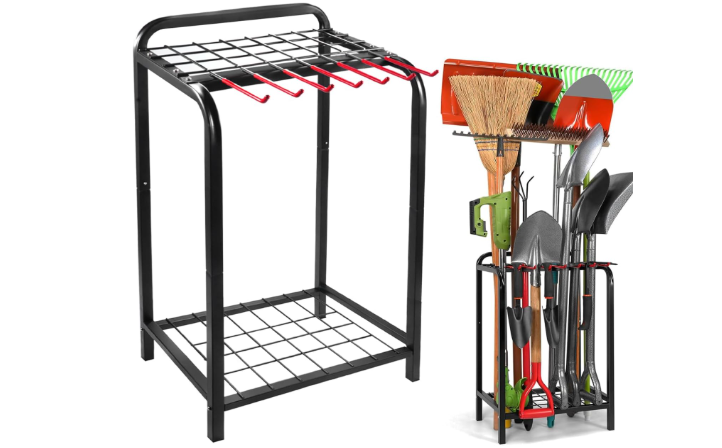
The Trieez organizer represents practical engineering focused on delivering dependable performance for everyday users. This sturdy yard tool rack emphasizes reliability over flashy features, creating a storage solution that consistently performs its intended function without complications.
Engineering for Dependability
The design philosophy prioritizes function over form, resulting in a straightforward organizer that excels at its primary mission. Every component serves a specific purpose without unnecessary complexity that might compromise reliability or complicate maintenance.
The construction employs proven materials and techniques that have demonstrated long-term success in demanding applications. Rather than experimenting with novel approaches, Trieez relies on established methods that deliver predictable results across various conditions and usage patterns.
Robust Construction Standards
The heavy-duty designation reflects the organizer’s ability to handle substantial loads without performance degradation. The structural components maintain their shape and function under stress, providing consistent tool support regardless of loading conditions.
Quality control measures ensure each unit meets specified performance standards before shipping. This attention to detail reduces the likelihood of premature failures and ensures customers receive products that perform as advertised throughout their service lives.
Practical Storage Solutions
The storage configuration accommodates common tool types without requiring special adapters or modifications. Standard rakes, shovels, hoes, and similar implements find secure homes without forcing awkward positioning or precarious balance.
The hook and bracket system maintains tools in their designated positions while allowing easy removal when needed. This balance between security and accessibility eliminates the frustration of tools falling unexpectedly while ensuring quick selection during busy periods.
Installation Simplicity
The straightforward installation process appeals to users who prefer simple solutions over complex systems requiring extensive setup procedures. Basic tools and common hardware accomplish the mounting process without specialized equipment or professional assistance.
Clear instructions guide the installation process step-by-step, reducing the likelihood of errors that might compromise performance or safety. The forgiving design tolerates minor installation variations without significant impact on functionality.
Long-Term Performance
The conservative design approach results in organizers that maintain their performance characteristics over extended periods. Components age gracefully without sudden failures that render the entire system unusable.
Regular maintenance requirements remain minimal, consisting primarily of occasional cleaning and hardware inspection. This low-maintenance approach appeals to users who want reliable storage without ongoing attention demands.
Value Proposition
The Trieez organizer delivers solid performance at a reasonable price point, making quality tool storage accessible to budget-conscious consumers. The cost-effective approach doesn’t sacrifice essential features while avoiding premium pricing for unnecessary extras.
The balance between price and performance makes this organizer particularly attractive for first-time buyers or those seeking to upgrade from basic storage methods without major financial commitment.
Target Market Alignment
This organizer serves homeowners with moderate tool collections who prioritize reliability over advanced features. The straightforward approach appeals to users who want effective storage without complexity or maintenance concerns.
Garden enthusiasts who focus on growing rather than equipment management find this organizer’s practical approach particularly appealing. The system organizes tools effectively without demanding attention that could be better spent on gardening activities.
4. Heavy Duty Garden Tool Organizer Garage Storage Holder – The Workhorse Solution
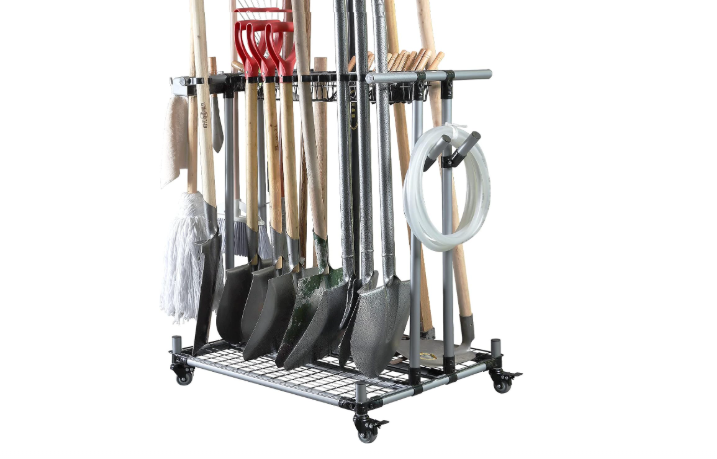
This industrial-strength organizer targets users who demand maximum durability and capacity from their storage systems. Built to handle the rigorous demands of professional use while remaining accessible to serious homeowners, this heavy-duty solution emphasizes strength and longevity above all other considerations.
Industrial-Grade Construction
The robust metal framework employs heavier gauge materials than typical residential organizers, providing the structural integrity necessary for demanding applications. The engineering approach borrows from commercial storage solutions, adapting industrial techniques for garden tool applications.
Connection methods utilize mechanical fasteners and welded joints that maintain their strength through repeated stress cycles. This construction philosophy ensures the organizer maintains its performance characteristics even under conditions that would overwhelm lighter alternatives.
Maximum Load Capacity
The heavy-duty designation reflects genuine capability rather than marketing hyperbole. This organizer handles substantial tool loads without deflection, sagging, or stability concerns that plague insufficient designs.
Large farming tools, commercial lawn equipment, and extensive collections find appropriate homes without exceeding the system’s design limits. The generous safety margins ensure reliable performance even when fully loaded with the heaviest implements.
Professional Application Focus
The design considerations reflect the needs of landscaping contractors, groundskeepers, and agricultural operations that depend on reliable tool access throughout demanding work schedules. The organizer must perform consistently regardless of weather conditions, usage intensity, or load variations.
Commercial durability standards guide material selection and construction methods, ensuring the organizer withstands the abuse common in professional environments. This attention to durability benefits residential users who want commercial-grade reliability in their home applications.
Specialized Storage Solutions
The organizer accommodates oversized implements that challenge conventional storage systems. Long-handled farming tools, commercial rakes, and specialized equipment find secure homes without requiring modifications or adaptations.
The storage configuration recognizes the unique requirements of agricultural and landscaping tools that differ significantly from typical garden implements. This specialization ensures optimal storage for equipment that serves professional and serious hobbyist applications.
Environmental Resistance
The protective coatings and material selections resist the environmental challenges common in agricultural and landscaping applications. Exposure to fertilizers, pesticides, and harsh weather conditions doesn’t compromise the organizer’s integrity or appearance.
The corrosion resistance extends the service life significantly compared to unprotected alternatives, reducing replacement costs and maintaining performance in challenging environments. This durability proves particularly valuable in coastal areas where salt exposure accelerates metal degradation.
Installation and Mounting
The substantial construction requires appropriate mounting techniques that distribute loads effectively across supporting structures. Professional installation may be advisable for optimal performance and safety in high-capacity applications.
The mounting hardware accommodates various structural configurations while providing the security necessary for heavy-duty applications. Proper installation ensures the organizer performs safely throughout its service life without risk of failure or detachment.
Cost-Benefit Analysis
The premium pricing reflects the genuine heavy-duty construction and materials rather than superficial upgrades. Users who require maximum durability find the investment justified by extended service life and reliable performance.
The total cost of ownership often favors heavy-duty organizers despite higher initial investment due to reduced replacement frequency and consistent performance over time. This economic advantage becomes more pronounced in professional applications where downtime costs exceed equipment costs.
5. Garage Organization Wall Mount with 48 Inches Rails – The Modular Marvel
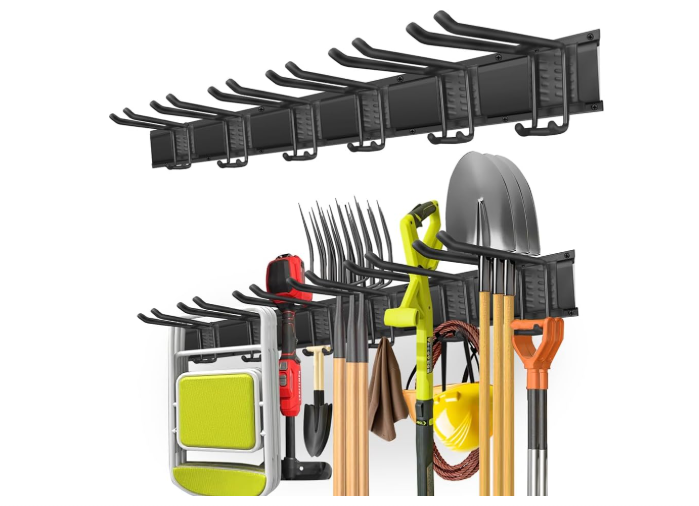
This sophisticated rail-based system represents the cutting edge of modular storage technology, offering unprecedented customization and expansion capabilities. The 48-inch rail system with six double-layer hooks creates a foundation for a storage solution that adapts to changing needs and growing tool collections.
Revolutionary Rail System Architecture
The modular rail design transforms storage organization from a fixed solution into a dynamic system that evolves with user needs. Unlike traditional organizers with predetermined configurations, this system allows infinite customization within the rail’s capacity limits.
The double-layer hook design maximizes storage density while maintaining tool accessibility. Tools can be stored at different depths along the rail, preventing interference while optimizing space utilization. This three-dimensional approach increases capacity without expanding the system’s footprint.
Advanced Hook Technology
The six included double-layer hooks represent sophisticated storage engineering that accommodates various tool types and sizes. Each hook adjusts to handle different implements while maintaining secure retention during storage.
The double-layer configuration allows tools to be stored at multiple depths, effectively doubling the rail’s capacity compared to single-layer systems. This innovation proves particularly valuable for users with extensive collections or limited wall space.
Customization and Expansion Options
The modular nature enables users to start with basic configurations and expand the system as collections grow. Additional rails and hooks integrate seamlessly with existing installations, creating storage systems that scale with user needs.
The flexibility extends to tool arrangement, allowing seasonal reorganization or workflow optimization based on changing requirements. This adaptability ensures the storage system remains relevant throughout evolving needs and applications.
Installation Versatility
The rail mounting system accommodates various wall types and configurations while maintaining the flexibility to relocate or reconfigure as needed. The mounting hardware provides secure attachment without permanent alterations that limit future options.
Multiple rail installations create comprehensive storage systems that transform entire walls into organized tool storage areas. The modular approach allows incremental expansion without requiring complete system replacement.
Quality Construction Standards
Despite the sophisticated design, the construction maintains the durability standards necessary for demanding applications. The rail system handles substantial loads while the hook mechanisms maintain their adjustment capabilities through repeated use.
The protective finishes resist environmental challenges while maintaining the system’s appearance throughout its service life. Quality materials ensure the modular components continue to function properly despite frequent reconfiguration and heavy use.
Professional and Residential Applications
The system’s adaptability serves both professional operations that require flexible storage solutions and homeowners who want storage systems that grow with their interests. The modular approach accommodates changing needs without requiring complete replacement.
Commercial applications benefit from the system’s ability to accommodate specialized tools and changing inventory requirements. Residential users appreciate the opportunity to start small and expand gradually as their tool collections grow.
Technology Integration
The rail system represents a technological advancement in storage solutions, moving beyond fixed configurations to embrace dynamic adaptability. This innovation positions the system at the forefront of storage technology evolution.
The engineering approach recognizes that tool storage needs change over time, providing a foundation for adaptation rather than forcing users to accept static solutions. This forward-thinking design philosophy ensures long-term relevance and value.
Installation Guide and Best Practices
Proper installation forms the foundation of effective tool storage, regardless of which organizer you choose. Understanding installation principles helps ensure optimal performance while avoiding common mistakes that compromise safety and functionality.
Wall Assessment and Preparation
Before beginning installation, thoroughly assess your wall structure to determine the appropriate mounting approach. Stud locations provide the most secure mounting points for heavy-duty organizers, while hollow wall anchors may suffice for lighter systems.
Use a stud finder to locate structural members accurately, marking their positions with pencil lines that remain visible throughout the installation process. Verify stud locations by drilling small pilot holes at marked positions, confirming solid wood contact before proceeding with full installation.
Tool and Hardware Requirements
Gather all necessary tools before beginning installation to avoid interruptions that might compromise the mounting process. Basic requirements typically include a drill with appropriate bits, level, measuring tape, pencil, and safety equipment.
Quality mounting hardware proves essential for reliable installation, particularly for heavy-duty organizers. Use screws and anchors rated for loads exceeding your organizer’s maximum capacity, providing adequate safety margins for unexpected conditions.
Mounting Height and Positioning
Position organizers at heights that provide comfortable access to stored tools while maximizing storage efficiency. Consider the heights of primary users and the lengths of stored tools when determining optimal mounting positions.
Allow adequate clearance above and below the organizer for tool insertion and removal without interference from ceiling, floor, or adjacent obstacles. This clearance proves particularly important for long-handled implements that require angled insertion.
Level Installation Techniques
Use a quality level throughout the installation process to ensure proper alignment and prevent operational problems. Unlevel installations create uneven weight distribution that can lead to premature failure or tool sliding.
Mark level reference lines before drilling mounting holes, double-checking measurements and alignment before making permanent attachments. Take time to verify level installation at multiple points throughout the mounting process.
Safety Considerations
Prioritize safety throughout the installation process, using appropriate personal protective equipment and following safe working practices. Secure ladders properly and maintain three points of contact when working at height.
Test the installation thoroughly before loading tools, gradually increasing loads while monitoring for any signs of stress, movement, or inadequate support. Address any concerns immediately rather than hoping problems resolve themselves over time.
Maintenance and Care Tips
Regular maintenance preserves your organizer’s performance and extends its service life significantly. Understanding proper care techniques helps prevent common problems while maintaining optimal functionality throughout years of service.
Routine Cleaning Procedures
Clean your organizer regularly to prevent dirt, debris, and corrosive substances from accumulating on critical surfaces. Use appropriate cleaning agents that remove contamination without damaging protective coatings or finishes.
Pay particular attention to pivot points, adjustment mechanisms, and mounting hardware where dirt accumulation might impair function. Regular cleaning prevents minor maintenance issues from developing into major problems requiring extensive repairs or replacement.
Lubrication and Adjustment
Moving parts require periodic lubrication to maintain smooth operation and prevent premature wear. Use appropriate lubricants that resist washout and contamination while providing long-lasting protection.
Inspect adjustment mechanisms regularly, ensuring they maintain their settings and operate smoothly. Tighten loose hardware promptly to prevent progressive loosening that might compromise the organizer’s integrity or safety.
Seasonal Inspection Schedules
Conduct thorough inspections at the beginning and end of each gardening season, checking for damage, wear, or environmental effects that might require attention. Early detection prevents minor issues from developing into major problems.
Document maintenance activities and inspection results to track the organizer’s condition over time. This record helps identify developing patterns that might indicate the need for repairs or replacement.
Weather Protection Strategies
Implement appropriate weather protection measures for organizers in exposed locations, extending their service lives while maintaining appearance and functionality. Simple protection strategies often provide significant benefits with minimal cost or effort.
Consider seasonal covers or storage modifications that protect the organizer during harsh weather periods when tool access requirements are minimal. These temporary measures can significantly extend service life in challenging environments.
Buying Guide: How to Choose the Right Organizer
Selecting the optimal lawn tool organizer requires careful consideration of multiple factors that affect both initial satisfaction and long-term value. Understanding these considerations helps ensure your choice aligns with your specific needs and circumstances.
Assessing Your Tool Collection
Begin by cataloging your current tool inventory, noting sizes, weights, and usage frequencies. This assessment provides the foundation for determining capacity requirements and storage configurations that best serve your needs.
Consider future tool acquisitions when evaluating capacity requirements, allowing room for collection growth without requiring organizer replacement. Slight overcapacity proves more economical than premature obsolescence due to insufficient storage.
Space Constraints and Opportunities
Measure your available storage space carefully, considering both floor area and vertical clearance requirements. Wall-mounted systems maximize floor space efficiency while freestanding units offer placement flexibility.
Evaluate traffic patterns and access requirements in your storage area, ensuring the organizer’s configuration doesn’t impede normal movement or create safety hazards. Consider how the organizer interacts with other storage systems and equipment in the area.
Usage Patterns and Workflow
Analyze your typical tool usage patterns to determine which storage configurations best support your workflow. Frequently used tools should occupy the most accessible positions, while seasonal items can accept less convenient locations.
Consider whether your tool usage varies seasonally or by project type, potentially requiring storage flexibility that accommodates changing priorities. Some organizers adapt more readily to changing requirements than others.
Budget Considerations
Establish realistic budget parameters that consider both initial purchase price and long-term value propositions. Higher-quality organizers often provide better total cost of ownership despite premium initial pricing.
Factor installation costs, potential accessories, and maintenance requirements into your budget calculations. Hidden costs can significantly impact the actual investment required for effective tool storage.
Quality and Durability Expectations
Define your durability requirements based on expected usage intensity, environmental conditions, and desired service life. Professional applications typically justify premium construction while casual use may find good value in basic systems.
Research manufacturer reputations, warranty coverage, and customer service quality when evaluating organizer options. These factors become particularly important if problems develop during the ownership period.
Common Mistakes to Avoid
Learning from others’ experiences helps prevent costly mistakes that compromise organizer performance or create safety hazards. Understanding common pitfalls guides better decision-making throughout the selection and installation process.
Underestimating Capacity Requirements
Many users underestimate their tool storage needs, selecting organizers with insufficient capacity for their current collections. This mistake forces awkward storage compromises or premature replacement with larger systems.
Account for seasonal tool variations and future acquisitions when determining capacity requirements. Slight overcapacity provides flexibility while preventing the frustration of inadequate storage.
Ignoring Installation Requirements
Inadequate attention to installation requirements often results in poor performance or safety hazards that could have been avoided with proper planning. Research installation requirements thoroughly before making purchase decisions.
Consider whether you possess the skills and tools necessary for proper installation, or factor professional installation costs into your budget calculations. Poor installation often creates more problems than it solves.
Overlooking Environmental Factors
Failure to consider environmental conditions in storage areas can lead to premature organizer failure or poor performance. Moisture, temperature extremes, and chemical exposure significantly impact organizer longevity and function.
Select organizers with appropriate environmental resistance for your specific conditions. Investing in proper environmental protection often costs less than premature replacement due to environmental damage.
Focusing Solely on Price
While budget considerations are important, focusing exclusively on initial purchase price often results in poor long-term value. Quality organizers typically provide better performance and longer service lives that justify premium pricing.
Consider total cost of ownership including installation, maintenance, and replacement costs when comparing options. The cheapest initial option often proves most expensive over time.
Conclusion: Making the Right Choice for Your Needs
Choosing the best lawn tool organizer requires balancing multiple factors including capacity, durability, installation requirements, and budget constraints. Each of the five organizers reviewed offers distinct advantages that serve different user needs and circumstances.
The 68″ All Metal Garden Tool Organizer represents the premium choice for users who demand maximum durability and professional performance. Its robust construction and comprehensive capacity justify the investment for serious gardeners and professional applications.
The 3 Tier Garden Tool Organizer excels as the capacity champion, accommodating extensive tool collections with its innovative tiered design. Users with large inventories or multiple tool categories benefit most from this comprehensive storage solution.
The Trieez Heavy Duty Garden Tool Organizer serves as the reliability expert, delivering consistent performance through proven design principles. This organizer appeals to users who prioritize dependable function over advanced features.
The Heavy Duty Garden Tool Organizer Garage Storage Holder functions as the workhorse solution for demanding applications. Professional users and those with specialized equipment needs benefit from its industrial-grade construction.
The Garage Organization Wall Mount with 48 Inches Rails stands as the modular marvel, offering unprecedented customization and expansion capabilities. Users who value flexibility and system growth potential find this option most appealing.
Your optimal choice depends on your specific circumstances, including tool collection size, available space, usage patterns, and performance expectations. Consider both current needs and future requirements when making your selection, ensuring your chosen organizer serves you effectively for years to come.
Proper installation and maintenance practices maximize your organizer’s performance and longevity regardless of which option you choose. Following manufacturer guidelines and implementing regular care procedures protect your investment while ensuring consistent functionality.
The right lawn tool organizer transforms chaotic storage into organized efficiency, saving time and protecting valuable equipment while creating a more pleasant working environment. Choose wisely, and enjoy the benefits of professional-quality tool organization for years to come.
